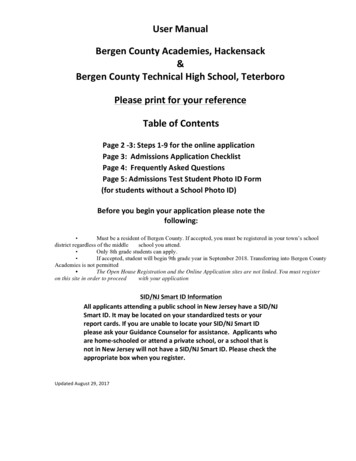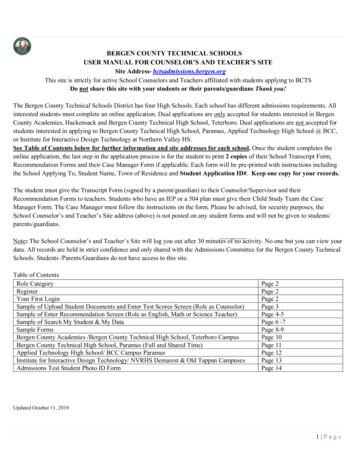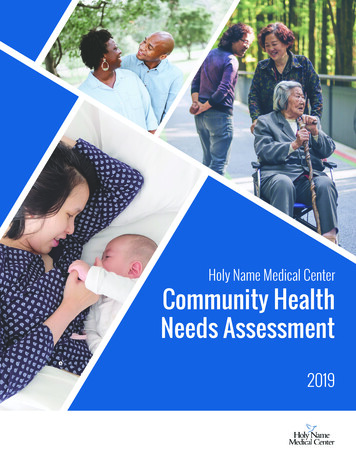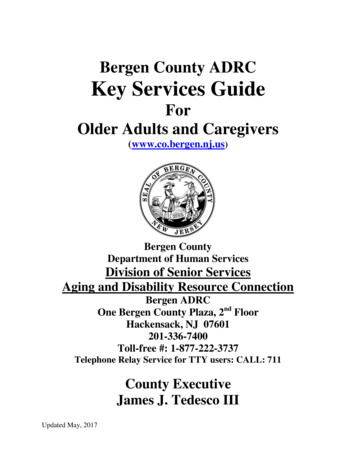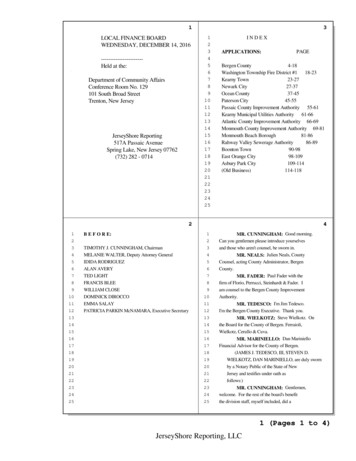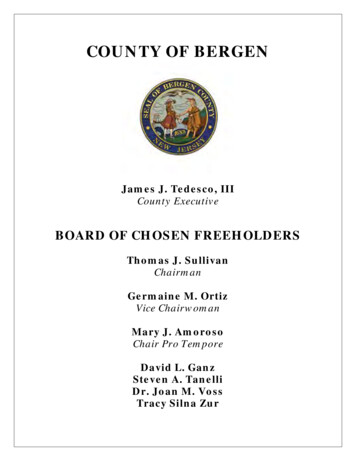
Transcription
COUNTY OF BERGENJames J. Tedesco, IIICounty ExecutiveBOARD OF CHOSEN FREEHOLDERSThomas J. SullivanChairmanGermaine M. OrtizVice ChairwomanMary J. AmorosoChair Pro TemporeDavid L. GanzSteven A. TanelliDr. Joan M. VossTracy Silna Zur
Bergen County is the most populous county of the state of New Jersey.As of the 2000Census, the population was 884,118, growing to 905,116 as of the 2010 Census and thepopulation estimate in July 2017 was 948,406. It is part of the New York Metropolitan Area.The county seat is Hackensack. In 2009 Bergen County ranked 16th among the highest incomecounties in the United States, in terms of per-capita income.HistoryAt the time of first European contact, Bergen County was inhabited by Native American people,particularly the Lenape groups of the Tappan, Hackensack and Rumachenanck (later calledthe Haverstraw). Today, some of the Ramapough Mountain Indians who reside in thenorthwest of the county trace their ancestry back to the Lenape and Munsee peoples.The area comprising today's Bergen and Hudson counties was part of New Netherland, the 17thcentury North American colonial province of the Dutch Republic. It had been claimedafter Henry Hudson (sailing for the Dutch East India Company) explored Newark Bay andanchored his ship at Weehawken Cove in 1609.Early settlement attempts by the Dutch included Pavonia (1633), Vriessendael (1640) and AchterCol (1642) but these settlements were repelled in Kieft's War (1643-1645) and the PeachTree War (1655-1660). Settlers again returned to the western shores of the Hudson in the1660 formation of Bergen, which would become the first permanent European settlementin the territory of the modern state of New Jersey.During the Second Anglo-Dutch War, on August 27, 1664, New Amsterdam surrendered to theEnglish Navy. The Province of New Jersey was then formed in 1674. In 1679, Bergen wasincluded in a judicial district with Essex, Monmouth and Middlesex counties, while the territorywas called East Jersey, a proprietary colony (as opposed to a royal colony). In 1683,Bergen (along with the three other counties) was officially recognized as an independentcounty by the Provincial Assembly.Initially, Bergen County consisted of only the land between the Hudson and the HackensackRivers, extending north to the border between East Jersey and New York. In January 1709, theboundaries were extended to include all the current territory of Hudson County (formed in 1840),and portions of Passaic County (formed in 1837). The 1709 borders were described as follows:"Beginning at Constable's Hook, so along the bay and Hudson's River to thepartition point between New Jersey and the province of New York; along thisline and the line between East and West Jersey" to the Pequaneck River; downthe Pequaneck and Passaic Rivers to the sound; and so following the sound toConstable's Hook the place of beginning."The line between East and West Jersey here referred to is not the line finally adopted and knownas the Lawrence line, which was run by John Lawrence in September and October, 1743.2
It was the compromise line agreed upon between Governors Coxe and Barclay in 1682, whichran a little north of Morristown to the Passaic River; thence up the Pequaneck to forty-onedegrees of north latitude; and thence by a straight line due east to the New York State line. Thisline being afterward objected to by the East Jersey proprietors, the latter procured the running ofthe Lawrence line.Bergen saw several battles and troop movements during the American Revolutionary War. FortLee's location atop the New Jersey Palisades, opposite Fort Washington in Manhattan, made it astrategic position during the war. In November, 1776 the Battle of Fort Lee took place as part ofthe Continental Army's attempts to keep British forces from sailing up the Hudson River. Afterthese defensive positions were hastily abandoned, the Continental forces staged a retreat throughpresent-day Englewood and Teaneck, and across the Hackensack River at New Bridge Landing;one of the few sites where the river was crossed by a bridge. With the British in pursuit, thisretreat allowed American forces to escape capture and regroup for subsequent successes againstthe British elsewhere in New Jersey later that winter. The Baylor Massacre took place in 1778 inRiver Vale, resulting in severe losses for the Continentals.In 1837, Passaic County was formed from parts of Bergen and Essex counties. In 1840, HudsonCounty was formed from Bergen. These two divisions lost roughly 13,000 residents (nearly halfof the previous population) from the county's rolls.In 1852, the Erie Railroad began operating major rail services from Jersey City on the HudsonRiver to points north and west via leased right-of-way in the county. This became known as theErie Main Line, and is still in use for passenger service today.In the late 19th century, state law was changed to allow easy formation of municipalities with theBorough form of government. This led to the Boroughitis phenomenon where many newmunicipalities were created in a span of a few years.On January 11, 1917, the Kingsland Explosion took place at a munitions factory in what is todayLyndhurst. The explosion is believed to be an act of sabotage by German agents, as themunitions in question were destined for Russia, part of the U.S.'s effort to supply allies beforeentrance into World War I. After the U.S. entry into the war in April 1917, Camp Merritt wascreated in eastern Bergen County for troop staging. Beginning operations in August 1917, ithoused 50,000 soldiers at a time, staging them for deployment to Europe via Hoboken. CampMerritt was decommissioned in November, 1919.In 1931, the George Washington Bridge was completed, linking Fort Lee to Manhattan. Thisconnection would spur development in the post-World War II era, developing much of thecounty to suburban levels. A second deck of traffic on the bridge was completed in 1962,expanding its capacity to 14 lanes.In 1955, the U.S. Army created a Nike Missile station at Campgaw Mountain (in the west of thecounty) for the defense of the New York Metropolitan Area from strategic bombers. In 1959, thesite was upgraded to house Nike-Hercules Missiles with increased range, speed and payloadcharacteristics. The missile site closed in June 1971.3
Meaning of the Name “Bergen”The origin of the name of Bergen County is a matter of debate. It is believed that the County isnamed for one of the earliest settlements, Bergen, settled in 1660 in the area known today asJersey City Heights in Hudson County. Several earlier sources attribute the name to Bergen,Norway, while others attribute it to Bergen op Zoom in the Netherlands. Still others attribute it tothe Dutch word meaning "hill" or "place of safety". Some sources say that the name is derivedfrom one of the earliest settlers of Nieuw Amsterdam (now New York City), Hans HansenBergen, a native of Norway, who arrived in New Netherlands in 1633.The name “Bergen,” originally derived from the word for “hill” in Norway, Belgium and theNetherlands, was applied to towns located on hills. New Jersey’s Bergen was originally asettlement on a hill. Therefore, the currently accepted theory is, that the geographical location ofthe original town is the most likely reason it was called Bergen.The name “Bergen” was later applied to the County, which was established in 1683. 4
Evolution of Bergen County*1676-1702PROPRIETARY NEW JERSEY divided into two distinct and separately governed provinces:East Jersey and West Jersey.EAST JERSEY’s Original Counties:BERGEN (1683)Essex (1683)Middlesex (1683)Monmouth (1683)WEST JERSEY’s Original Counties:Burlington (1681)Cape May (1685)Gloucester (1686)Salem (1681)March 7, 1683BERGEN COUNTY established within the territory of East Jersey.1693BERGEN COUNTY divided intoBergen TownshipHackensack Township*Most of the information and maps are from “Bergen County’s Townships & Municipalities”by Arnold Lang and the Genealogical Society of Bergen County: http://njgsbc.org/5
1710BERGEN COUNTYBergen TownshipHackensack TownshipNew Barbadoes Township separated from Aquackanonk Township in Essex County,greatly expanding Bergen County.[Community of Hackensack was made the County Seat]1716BERGEN COUNTYBergen TownshipHackensack TownshipNew Barbadoes TownshipSaddle River Township breaks off of New Barbadoes Township1772BERGEN COUNTYBergen TownshipHackensack TownshipNew Barbadoes TownshipSaddle River TownshipFranklin Township breaks off of Saddle River Township6
1775BERGEN COUNTYBergen TownshipHackensack TownshipNew Barbadoes TownshipSaddle River TownshipFranklin TownshipHarrington Township formed from parts of Hackensack and New Barbadoes Townships[Revolutionary War Period]1797BERGEN COUNTYBergen TownshipHackensack TownshipNew Barbadoes TownshipSaddle River TownshipFranklin TownshipPompton Township formed from parts of Franklin & Saddle River TownshipsHarrington Townships1826BERGEN COUNTYBergen TownshipHackensack TownshipNew Barbadoes TownshipSaddle River TownshipFranklin TownshipPompton TownshipHarrington TownshipLodi Township formed from part of New Barbadoes Township7
1834BERGEN COUNTYBergen TownshipHackensack TownshipNew Barbadoes TownshipSaddle River TownshipFranklin TownshipPompton TownshipWest Milford Township formed from Franklin & Saddle River TownshipsHarrington TownshipLodi Township1837BERGEN COUNTYBergen TownshipHackensack TownshipNew Barbadoes TownshipSaddle River Township – part to Passaic CountyFranklin TownshipHarrington TownshipLodi TownshipPASSAIC COUNTYEntire western section of BERGEN COUNTY - Pompton Township, West MilfordTownship, part of Saddle River Township – and Township of Acquackanonk in Essex County,are annexed to form Passaic County.1840BERGEN COUNTYHackensack TownshipNew Barbadoes TownshipSaddle River TownshipFranklin TownshipHarrington TownshipWashington Township formed from part of Harrington TownshipLodi Township – part to Hudson County8
HUDSON COUNTYSouthern part of BERGEN COUNTY - Bergen Township, part of Lodi Township - broke off toform Hudson County.Bergen County was left with less than 50% of its previous population after formation of Passaicand Hudson Counties.1849BERGEN COUNTYHackensack TownshipNew Barbadoes TownshipSaddle River TownshipFranklin TownshipHo-Ho-Kus Township was set off from the northern part of Franklin TownshipHarrington TownshipWashington TownshipLodi Township1852 - 1860BERGEN COUNTYHackensack TownshipNew Barbadoes Township9
Saddle River TownshipFranklin TownshipHo-Ho-Kus TownshipHarrington TownshipWashington TownshipLodi Township1860 - Carlstadt Village formed within Lodi Township1852 - Union Township formed from areas that had been transferred to Hudson County in 1840(and added back after people petitioned to be returned to Bergen County)1871BERGEN COUNTYHackensack Township was divided into 3 townships and ceases, in name, to exist:Englewood Township, Palisades Township, Ridgefield TownshipNew Barbadoes TownshipSaddle River TownshipFranklin TownshipHo-Ho-Kus TownshipHarrington TownshipWashington TownshipLodi TownshipCarlstadt VillageMidland Township set off from New Barbadoes TownshipUnion Township1876-1881BERGEN COUNTYEnglewood TownshipPalisades TownshipRidgefield TownshipNew Barbadoes TownshipSaddle River TownshipFranklin TownshipHo-Ho-Kus TownshipRidgewood Township formed from Franklin TownshipHarrington TownshipWashington TownshipLodi TownshipCarlstadt VillageMidland TownshipUnion Township1881 - Rutherford Borough in 1890 fully separates from township form of government.1886BERGEN COUNTYEnglewood TownshipPalisades Township10
Ridgefield TownshipNew Barbadoes TownshipSaddle River TownshipFranklin TownshipHo-Ho-Kus TownshipOrvil Township set off from parts of both Ho-Ho-Kus & Washington TownshipsRidgewood TownshipHarrington TownshipWashington TownshipLodi TownshipCarlstadt VillageMidland TownshipUnion TownshipRutherford Borough1889BERGEN COUNTYEnglewood TownshipPalisades TownshipRidgefield TownshipNew Barbadoes TownshipSaddle River TownshipFranklin TownshipHo-Ho-Kus TownshipOrvil TownshipRidgewood TownshipHarrington TownshipWashington TownshipLodi TownshipCarlstadt VillageMidland TownshipUnion TownshipRutherford BoroughBoiling Springs Township set off from Union Township (later became East Rutherford)1890-1893BERGEN COUNTYEnglewood TownshipPalisades TownshipRidgefield Township1892 - Ridgefield Borough1892 - Ridgefield Park VillageNew Barbadoes TownshipSaddle River TownshipFranklin TownshipHo-Ho-Kus TownshipOrvil Township11
Ridgewood TownshipHarrington TownshipWashington TownshipLodi TownshipCarlstadt Village1893 - Bergen TownshipMidland TownshipUnion TownshipRutherford BoroughBoiling Springs Township1894New Jersey legislature passed a school act that made each township a separate school district.Under this act, “boroughs, towns, villages and cities” would be exempted from the obligation topay, pro rata, existing debts of the old districts in addition to all future debts of the townships forschool purposes. The rush was on to create new boroughs.12
January 23 – December 18, 1894“BOROUGHITIS”26 boroughs were carved from the early townships.1895 – PRESENTThe formation of municipalities continued until 1924 when the number reached 70.Today Bergen County consists of:(With original dates of incorporation or formation)3 CitiesEnglewood (1899), Garfield (1898), Hackensack (1921)2 VillagesRidgefield Park (1892), Ridgewood (1876)9 TownshipsLyndhurst (1917), Mahwah (1944), River Vale (1906), Rochelle Park (1929), Saddle Brook(1955), South Hackensack (1935), Teaneck (1895), Washington (1840), Wyckoff (1926)56 BoroughsAllendale (1894), Alpine (1903), Bergenfield (1894), Bogota (1894), Carlstadt (1894), CliffsidePark (1895), Closter (1904), Cresskill (1894), Demarest (1903), Dumont (1894), East Rutherford(1889), Edgewater (1894), Elmwood Park (1916), Emerson (1898), Englewood Cliffs (1895),Fair Lawn (1924), Fairview (1894), Fort Lee (1904), Franklin Lakes (1922), Glen Rock (1894),Harrington Park (1904), Hasbrouck Heights (1894), Haworth (1904), Hillsdale (1898), Ho-HoKus (1905), Leonia (1894), Little Ferry (1894), Lodi (1894), Maywood (1894), Midland Park(1894), Montvale (1894), Moonachie (1910), New Milford (1922), North Arlington (1896),Northvale (1916), Norwood (1905), Oakland (1902), Old Tappan (1894), Oradell (1894),Palisades Park (1899), Paramus (1922), Park Ridge (1894), Ramsey (1908), Ridgefield (1892),River Edge (1894), Rockleigh (1923), Rutherford (1881), Saddle River (1894), Tenafly (1894),Teterboro (1917), Upper Saddle River (1894), Waldwick (1919), Wallington (1895), Westwood(1894), Woodcliff Lake (1894), Wood-Ridge (1894)13
Types of Municipalities in Bergen CountyBOROUGHA Borough (sometimes abbreviated Boro on road signs) in the context of New Jersey localgovernment refers to one of five types and one of eleven forms of municipal government.Though it is now the most common form of government in New Jersey, as of 1875, only 17boroughs had been created, all by special acts of the legislature.The Borough Act of 1878 allowed any township (or portion thereof) with a land area of no morethan four square miles and a population not exceeding 5,000, to establish itself as an independentborough through a petition and referendum process on a self-executing basis. As enacted, aborough would be governed by an elected mayor (serving a one-year term) and a six-membercouncil (elected to staggered three-year terms). The mayor would preside at council meetings,but had no vote except to break ties. Waves of boroughs were incorporated by newly-mintedmunicipalities to allow for home-ruled school districts.14
The Borough Act of 1897 amended the original Act, eliminating the self-executing incorporationfeature of the earlier legislation. Henceforth, newly incorporated boroughs (or those seeking todissolve or increase or decrease in size) required approval of the legislature. The elected mayorand six-member council were retained, with the mayor now serving a two-year term.The Borough Act of 1987 was created to streamline borough law and clear away amendments,changes and contradictory rules that had accumulated over the century of the Borough'sexistence as a form of government. The 1987 Act allowed for the delegation of executiveresponsibility to an appointed administrator.Traditionally, voters elect a mayor and six council-members at-large in a partisan election. Theborough system has a weak mayor and the council performs most legislative and executivefunctions. This form of local government is used by 39% of the municipalities in New Jersey.BoroughitisBoroughitis was a craze that swept through New Jersey in the late 19th century, which ledgroups of residents to unite to form Boroughs from within and among the many Townships thatwere the prevalent form at the time. This wave of municipal formations was fomented bylegislation that allowed a Borough to be created by a referendum with no further legislativeapproval required. By 1875 only 17 boroughs existed, but with Boroughitis the prevalence ofBoroughs exploded, so that they are now the most common type of municipal government inNew Jersey, accounting for over 200 of the 566 municipal governments statewide.CITYA City in the context of New Jersey local government refers to one of five types and one ofeleven forms of municipal government.Despite the widely-held perception of a city as a large, urban area, cities in New Jersey have aconfused history as a form of government and vary in size from large, densely populated areas tomuch-smaller hamlets.The 1897 and 1899 city charter laws applied only to areas with a population under 12,000, andprovided for a directly-elected mayor, who served a two-year term and had strong executivepowers. Both featured a council elected from wards to staggered three-year terms, plus onecouncilman elected at-large for a term of two years. The Mayor had veto power, which could beoverridden by a two-thirds vote of the Council. The two acts differed in a number of ways,including the process for selection of a Board of Education (1897: elected; 1899: appointed byCouncil).By 1987, there were only eleven cities under these City Acts (including East Orange, whicheffectively operated under a special City charter). As in other forms, many amendments,revisions and changes had been made over the years, leading to confusing and often conflictinglegislation.The City Act of 1987 provides for a directly-elected mayor who serves a four-year term and for acouncil that consists of seven members; six elected from two wards for staggered three-yearterms and one elected at large for a four year term. There are three councilmen in each ward with15
one councilmember from each ward up for election every year. The mayor is the chief executiveand votes only to break a tie. The Mayor has veto power over all or portions of any ordinance,subject to override by a two-thirds vote of the Council. The Act also provides for the delegationof executive responsibilities to a municipal administrator.Those cities operating under pre-1987 charters could retain the characteristics of their structureof government regarding terms of office, number of positions and other powers. Provisions of the1987 Act can then be adopted through a petition and referendum process by the electorate.TOWNSHIPA township, in the context of New Jersey local government, refers to one of five types and one ofeleven forms of municipal government. It is a political entity as any typical town, city ormunicipality, collecting property taxes and providing services such as maintaining roads,garbage collection, water, sewer, schools, police and fire protection.However, townships in New Jersey differ from townships elsewhere in the United States. In moststates, townships are an intermediate form of government, between county government andmunicipalities that are subordinate parts of the township, with different governmentresponsibilities allocated at each level. In New Jersey, there are no subordinate municipalitieslocated within a township, as a New Jersey township is a form of municipal government within acounty, equal in status to a village, town, borough, or city, all of which may coexist within acounty.Municipalities in New Jersey may be classified into one of five types. This has little bearing onwhich of eleven forms of government that the municipality may adopt.Historically, a variety of legislation has been passed by the state legislature that has defined andrefined the township form of municipal government:The Township Act of 1798 was the first state legislation to incorporate municipalities. Thegovernment defined was a form of direct democracy, similar to the New England town meeting,in which the vote was available to all white males, at least 21 years old, who were citizens ofNew Jersey, and residents of the township for at least six months; and who paid taxes in thetownship, or who owned land, or rented a home in the township for a rent of at least five dollarsa year. A group of five freeholders was elected to one-year terms on the Township Committee,which was responsible to oversee the expenditure of revenue in between town meetings.The Township Act of 1899 abolished the town meeting and strengthened the role of theTownship Committee, which was initially set at three and amended to allow for expansion to fivemembers. Members were elected for staggered three-year terms.The Home Rule Act of 1917 legally defined the term "municipality" and recognized five types ofgovernment: borough, township, city, town, and village and granted each equal legal standing.The Township Act of 1989 simplified the much-amended Act of 1899. It retains a three or fivemember township committee serving staggered terms, whose members are generally elected at16
large. The committee elects a mayor from among its members to serve a one-year term. Partisanelections are allowed under this law. Voters may initiate a referendum to change the membershipto consist of either 3 or 5 members. While many township committees directly supervise theoperation of their municipality, the revised act allows the committee to delegate all or a portionof its responsibilities to an appointed municipal administrator.VILLAGEA Village in the context of New Jersey local government, refers to one of five types and one ofeleven forms of municipal government.The Village Act of 1891 defined the form of government to consist of a five member board oftrustees to be elected to three-year staggered terms. One member serves as president, onemember serves as treasurer. This act was repealed by the State Legislature in 1961.The Village Act of 1989 changed the essence of the Village form of government, essentiallyeliminating it in all but name. As of January 1, 1990, every village operating under the Villageform of government had to operate according to the laws pertaining to the Township form.Essentially, the Village form of government is now identical to the Township form, except thatthe Township Committee and Mayor in the Township form correspond to the Board of Trusteesand the President of the Board in the Village form.17
Seal of Bergen CountyIn 1983, in celebration of the County’s tri-centennial, a new seal of Bergen County was created.George Woodbridge, an artist from Brooklyn and a Revolutionary War buff who has illustratedbooks on uniforms and weaponry, drew it. This seal accentuates the county’s founding year,1683, in scrollwork between a Dutch settler-trader and Indian shaking hands on the banks of theHudson beneath the Palisades. The Dutchman’s ship is anchored offshore. Perched above them isan eagle.These same elements were also in the old seal, which had been in use since 1910. That sealcontained two dates (1617 and 1910) of no particular significance to the county’s history. Theoriginal design was fairly amateurish. In the new seal, the Dutchman’s musket has been removedand he is now portrayed as a settler, an explorer and trader. The Indian has been given a peacepipe and portrayed more historically accurate as eastern woodlands Indian. The original seal hadhim in western Indian headdress.18
GeographyAccording to the U.S. Census Bureau, the county has a total area of 247 square miles (639.7km²), of which 234 square miles (606.1 km²) is land and 13 square miles (33.7 km²) (5.12%) iswater.The highest elevation is Bald Mountain near the New York state line in Mahwah, at 1,152 feet(351 m) above sea level. The lowest point is sea level, along the Hudson River, which in thisregion is more of a tidal estuary than a river.The sharp cliffs of the New Jersey Palisades lift much of the county up from the river along theeastern boundary with the Hudson River, but then relief remains relatively minimal across thecounty as much of it is in the Hackensack River valley. Only in the northwestern portion of thecounty are any serious hills found, leading to the Ramapo MountainsThe damming of the Hackensack River and a tributary, the Pascack Brook, produced threereservoirs in the county, Woodcliff Lake Reservoir, Lake Tappan and Oradell Reservoir, whichprovide drinking water to much of northern New Jersey. The Hackensack River drains theeastern portion of the county through the New Jersey Meadowlands, a wetlands area in thesouthern portion of the county. The central portion is drained by the Saddle River and thewestern portion is drained by the Ramapo River. Both of these are tributaries of the PassaicRiver, which forms a section of the southwestern border of the county.Bergen County is bordered by Rockland County, New York to the north, by Westchester County,The Bronx, and Manhattan in New York, across the Hudson River to the east, Hudson County tothe south, a small border with Essex County also to the south and Passaic County to the west.ClimateBergen County lies at the edge of the humid subtropical climate zone according to the Koppenclimate classification because its coldest month (January) averages above 26.6 F / -3 C. In partdue to its coastal location and low elevation, it is milder than cities further inland such asChicago.19
Law and GovernmentIn November 1986, Bergen's form of government changed. Instead of nine Freeholders, voterschose a County Executive and seven Freeholders. The current County Executive is Kathleen A.Donovan, the first and only female County Executive in the State of New Jersey. The Executive,along with the Board of Chosen Freeholders, administer all county business.The seven Freeholders are elected at-large to three-year terms in office on a staggered basis, witheither two or three seats coming up for election each year. As of 2013, Bergen County'sFreeholders are: Chairman David L. Ganz Vice Chairwoman Joan M. Voss Chairman Pro Tempore John A. Felice Maura R. DeNicola John D. Mitchell Steven A. Tanelli Tracy Silna ZurBergen County also elects three Constitutional Officers, separately from the CountyExecutive and Freeholder Board. They are Sheriff Michael Saudino, SurrogateCourt Judge Michael R. Dressler, and County Clerk John S. Hogan.There are eight Departments that are part of county government: Department of Administration and Finance includes the Offices of InformationTechnology, Fiscal Operations, Personnel, Purchasing and Treasury. Thisdepartment ensures maximum efficiency, cost-effectiveness and quality servicefor the County's taxpayers. Department of Health Services promotes optimal health, disease prevention, andprotects the environment. Its divisions and programs include Addiction RecoveryProgram, Animal Control, Animal Shelter, Behavioral Health, Center, Bergen CountyHealth Care Center, Environmental Health, Hazardous Materials Response Program,Health Counseling Center, Health Promotion, Public Health Nursing, Special ChildHealth Services, and Spring House for Women. Department of Human Services provides services to support individuals andfamilies. A skilled professional staff works within eight divisions to provide servicesthat include clinical, residential, and correction services for youth, coordination of childcare, assisted transportation, domestic violence intervention, information and referral,counseling, and assistance. The Department also contracts with over 50 communitybased agencies to provide specialized services.20
Department of Law is led by the County Counsel. There are two divisions. TheCounty Counsel’s Office is legal counsel to the County Executive, the eightdepartments and the offices of the Sheriff, County Clerk, Surrogate and Prosecutor.The Adjuster's Office is the liaison between the courts and the psychiatric institutionsof the state, performs investigations and assists in the processing of gun applications. Department of Parks is in charge of the recreational and cultural services of thecounty. Bergen County boasts an excellent park system where residents can ski,skate, jog, cycle, golf, picnic, and camp overnight, tour a zoo, visit a Revolutionary Warbattle site, take a guided nature hike, swim, and play softball and tennis. Some of thecounty's facilities include a nationally accredited zoo, five golf courses, 19 parks, twostables, an environmental center and nine historic sites. Other divisions under Parks areCultural & Historic Affairs and Multicultural Community Affairs. Department of Planning and Economic Development is charged with shaping thecounty's environmental and economic future. Its divisions include CommunityDevelopment, Engineering and Administration, Land Use & Development Review,Open Space, Public/Private Partnerships, Data Resources & Technology, RegionalPlanning & Transportation and Master Planning. It also encompasses the BergenCounty Planning Board and the Construction Board of Appeals. Department of Public Safety provides public safety services for the county. Includedin this department are the County Police and the divisions of ConsumerAffairs/Consumer P
Dr. Joan M. Voss . Tracy Silna Zur. 2 . Bergen County. is the most populous county of the state of New Jersey. As of the 2000 Census, the population was 884,118, growing to 905,116 as of the 2010 Census and the population estimate in July 2017 was 948,406. It is part of the New York Metropolitan Area.
